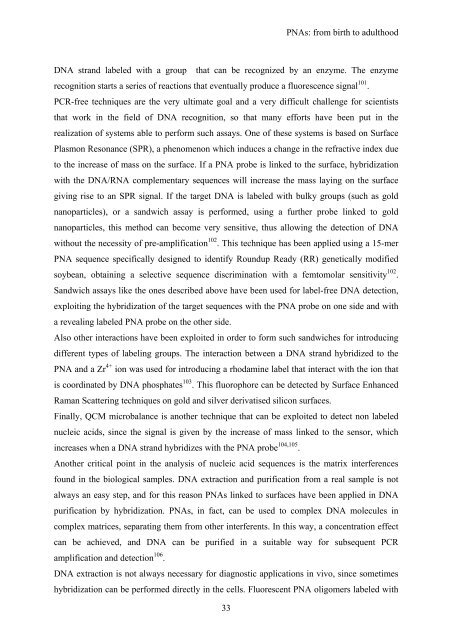View - DSpace UniPR
View - DSpace UniPR
View - DSpace UniPR
Create successful ePaper yourself
Turn your PDF publications into a flip-book with our unique Google optimized e-Paper software.
PNAs: from birth to adulthood<br />
DNA strand labeled with a group that can be recognized by an enzyme. The enzyme<br />
recognition starts a series of reactions that eventually produce a fluorescence signal 101 .<br />
PCR-free techniques are the very ultimate goal and a very difficult challenge for scientists<br />
that work in the field of DNA recognition, so that many efforts have been put in the<br />
realization of systems able to perform such assays. One of these systems is based on Surface<br />
Plasmon Resonance (SPR), a phenomenon which induces a change in the refractive index due<br />
to the increase of mass on the surface. If a PNA probe is linked to the surface, hybridization<br />
with the DNA/RNA complementary sequences will increase the mass laying on the surface<br />
giving rise to an SPR signal. If the target DNA is labeled with bulky groups (such as gold<br />
nanoparticles), or a sandwich assay is performed, using a further probe linked to gold<br />
nanoparticles, this method can become very sensitive, thus allowing the detection of DNA<br />
without the necessity of pre-amplification 102 . This technique has been applied using a 15-mer<br />
PNA sequence specifically designed to identify Roundup Ready (RR) genetically modified<br />
soybean, obtaining a selective sequence discrimination with a femtomolar sensitivity 102 .<br />
Sandwich assays like the ones described above have been used for label-free DNA detection,<br />
exploiting the hybridization of the target sequences with the PNA probe on one side and with<br />
a revealing labeled PNA probe on the other side.<br />
Also other interactions have been exploited in order to form such sandwiches for introducing<br />
different types of labeling groups. The interaction between a DNA strand hybridized to the<br />
PNA and a Zr 4+ ion was used for introducing a rhodamine label that interact with the ion that<br />
is coordinated by DNA phosphates 103 . This fluorophore can be detected by Surface Enhanced<br />
Raman Scattering techniques on gold and silver derivatised silicon surfaces.<br />
Finally, QCM microbalance is another technique that can be exploited to detect non labeled<br />
nucleic acids, since the signal is given by the increase of mass linked to the sensor, which<br />
increases when a DNA strand hybridizes with the PNA probe 104,105 .<br />
Another critical point in the analysis of nucleic acid sequences is the matrix interferences<br />
found in the biological samples. DNA extraction and purification from a real sample is not<br />
always an easy step, and for this reason PNAs linked to surfaces have been applied in DNA<br />
purification by hybridization. PNAs, in fact, can be used to complex DNA molecules in<br />
complex matrices, separating them from other interferents. In this way, a concentration effect<br />
can be achieved, and DNA can be purified in a suitable way for subsequent PCR<br />
amplification and detection 106 .<br />
DNA extraction is not always necessary for diagnostic applications in vivo, since sometimes<br />
hybridization can be performed directly in the cells. Fluorescent PNA oligomers labeled with<br />
33
















